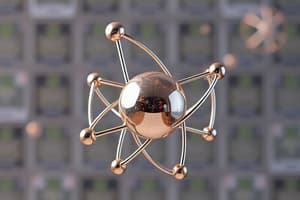Podcast
Questions and Answers
What is ionization energy?
What is ionization energy?
- The amount of energy needed to remove an electron from an atom or ion (correct)
- The amount of energy needed to add an electron to an atom
- The energy released when an electron is added to an atom
- The energy released when an electron is removed from an atom or ion
How does the effective nuclear charge affect the position of electrons in an atom?
How does the effective nuclear charge affect the position of electrons in an atom?
- It has no effect on the position of electrons
- It repels the electrons, leading to an increase in energy level radius (correct)
- It attracts the electrons, leading to a decrease in energy level radius
- It causes the electrons to move to a higher energy level
How does ionization energy change as we move down a group in the periodic table?
How does ionization energy change as we move down a group in the periodic table?
- It remains constant
- It increases
- It fluctuates unpredictably
- It decreases (correct)
What happens to the nucleus charge when a negative ion is formed?
What happens to the nucleus charge when a negative ion is formed?
What is the relationship between nucleus charge and the attraction force on electrons?
What is the relationship between nucleus charge and the attraction force on electrons?
What happens to the repulsion force between electrons as the number of electrons in a negative ion increases?
What happens to the repulsion force between electrons as the number of electrons in a negative ion increases?
How does the nucleus charge affect the attraction force on electrons and its involvement in decreasing the gradation of properties in the periodic table?
How does the nucleus charge affect the attraction force on electrons and its involvement in decreasing the gradation of properties in the periodic table?
What is ionization energy?
What is ionization energy?
What happens to ionization energy as we move down a group in the periodic table?
What happens to ionization energy as we move down a group in the periodic table?
How does the larger effective nuclear charge affect the position of electrons in an atom?
How does the larger effective nuclear charge affect the position of electrons in an atom?
Flashcards are hidden until you start studying
Study Notes
The Modern Periodic Table
- Consists of 18 groups (vertical) and 7 rows (horizontal)
- Can be divided into 4 blocks: Block P, Block S, Block D, and Block F
Atomic Radius
- Defined as the distance between the center of two identical atoms in one molecule
- In a row (horizontal):
- Decreases with increasing atomic number
- Due to increasing positive charge in the nucleus and the electron added in the same level not shielding from the nuclear pull or attraction
- In a column (vertical):
- Increases with increasing atomic number
- Due to:
- Electron added in the new level being far away from the nuclear charge
- Full energy levels shielding the effect of the nucleus force from the outer electrons level
Ionic Size
- Positive ion:
- Outer electrons are removed, resulting in a nucleus with more positive charge than the total negative charge from electrons
- Impacts ionic size due to the changed charge balance
Studying That Suits You
Use AI to generate personalized quizzes and flashcards to suit your learning preferences.




